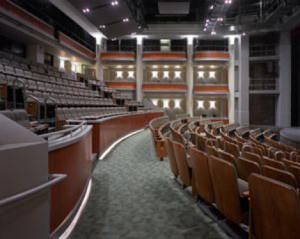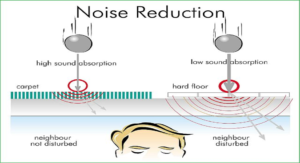Sound Absorption
Specifying for Acoustics
Noise Penetration Reduction
Carpet is an outstanding sound absorptive material. No other acoustical material performs the dual role of a floor covering and a versatile acoustical aid. When properly selected, carpet absorbs airborne noise as efficiently as many specialized acoustical materials. However, it is important to understand the acoustical values of particular carpet constructions and the combinations of specific carpet cushions. This information will assist you in selecting the appropriate combination for a specific purpose.
Carpet with a quality pad can do a very reasonable job of minimizing footstep noise to space below. If the construction quality of the floor and ceiling system is above average you can expect the noise downstairs to be acceptable. Our soundproof carpet padding will outperform readily available products. A much bigger issue for carpet soundproofing is the passage of loud noise through the air. Carpet and a pad, even the heaviest pad available, cannot block noise from loud kids, stereo/tv noise, floor to floor noise from bars, restaurants, and commercial tenants.
Sound Absorption
Sound absorption coefficients, the fraction of incident sound energy that is absorbed by a material, usually vary strongly with frequency. A noise reduction coefficient (NRC) is used to grade the effectiveness of a material employed for sound control.
Small samples can be measured by the impedance tube method, while larger specimens can be measured by the reverberation room method. Reverberation room coefficients are usually provided as a single number, NRC. This number is the average of the coefficients at 250, 500, 1000, and 2000 Hz (from low- to high-pitched sounds).
Sound Transmission
Transmission through walls, floors, and other barriers is much greater for low-frequency sounds than for high-frequency sounds. Sound transmission is measured between two reverberation rooms for at least 16 standard frequency bands.
For convenience in comparison to different constructions, the sound transmission class (STC) rating condenses sound transmission information into a single number according to ASTM E-413. STC is fairly accurate for human speech; however, for low-frequency sounds, such as a motor, fan, or even music with strong bass, the perceived sound may be greater than that indicated by STC.
Acoustics Specification:
When properly selected, carpet is an outstanding sound absorptive material as it absorbs airborne noise as efficiently as many specialized acoustical materials. As soon as the carpet is installed over a hard-surface floor the impact sound transmission to rooms below is an obvious acoustical advantage. No other acoustical material performs the dual role of a floor covering and versatile acoustical aid. Understanding the acoustical values of carpet constructions and the combinations of specific carpet cushions is important.
Sound absorption: A noise reduction coefficient (NRC) is used in grading the effectiveness of material employed for sound control. Sound absorption coefficients, the fraction of incident sound energy that is absorbed by the material, vary strongly with frequency.
Small samples can be measured by the impedance tube method, while larger specimens can be measured by the reverberation room method. Reverberation room coefficients are usually provided as a single number, NRC. This number is the average of the coefficients at 250, 500, 1000, and 2000 Hz (from low- to high-pitched sounds).
Sound transmission: Transmission through walls, floors, and other barriers is much greater for low-frequency sounds than for high-frequency sounds. Sound transmission is measured between two reverberation rooms for at least 16 standard frequency bands.
For convenience in comparison to different constructions, the sound transmission class (STC) rating condenses sound transmission information into a single number according to ASTM E-413. STC is fairly accurate for human speech. For low-frequency sounds, such as a motor, fan, or even music with strong bass, the perceived sound may be greater than that indicated by STC.
You may be left with questions. If that's the case, give us a call and our team of professional technicians will help you to solve your noise problem with the right carpet for you.


